This page may contain affiliate links that allow us to make a small commission from qualifying purchases (at no extra cost to yourself). We appreciate your support.
Terrariums are great if you are living in small spaces or if you struggle to grow plants but have a desire to add some greenery to your home decor. You can customize the size of your terrarium to suit the space that you have, making them great additions to any home or business. The big question on everyone’s mind however, is are terrariums hard to maintain? I decided to do some research and find out exactly how much maintenance they require.
As a whole, terrariums are not hard to maintain and require very little daily maintenance. Terrarium maintenance involves cleaning, watering, adjusting for sunlight, pruning plants, and looking for signs of deterioration.
In this article I have taken all of the research I have done and put together a complete care guide, covering step-by-step the most essential parts of maintaining a terrarium. Included you will also find common mistakes and things to look out for so that you can keep your terrarium healthy and strong with as little effort as possible!
Closed vs Open Terrarium: What type is yours?
There are two types of plant terrariums, open and closed. Understanding the difference between the two is essential to keeping your terrarium healthy and strong. Below is a brief description describing the main differences between the two types.
Closed Terrarium
Closed terrariums are fully enclosed containers, usually made from glass with a removable lid providing access for maintenance. They are an ideal environment for plants that thrive in wet, humid conditions, with indirect light. Closed terrariums create their own water cycle through high degrees of humidity and moisture. If your wanting a mini tropical paradise then this is the
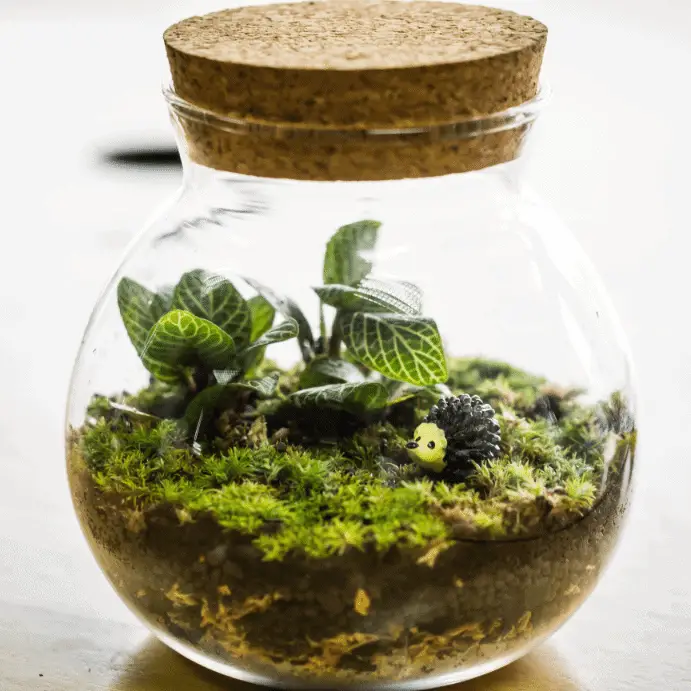
Open Terrarium
Open terrariums do not require a lid and are not fully enclosed. They are best suited for plants that love the sun and do not require a moist environment. Open terrariums prefer circulating air and drier conditions which makes them great for outdoors. Succulents and Cacti are the best choice for an outdoor open terrarium, however, if storing your terrarium indoors, most houseplants can be used as well.
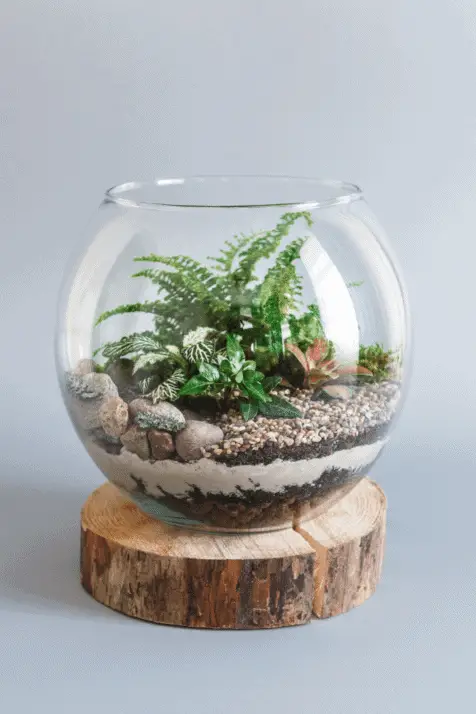
If your interested in an outdoor terrarium, then be sure to check out this article telling you everything you need to know!
How To Clean A Terrarium
Cleaning your terrarium is essential to keeping your plants healthy and strong. Below is a step-by-step guide for how to clean your terrarium both before and after it has been filled with plants. Although not required, we have also included a list of items that will make your terrarium maintenance more efficient and much faster.
Recommended Items:
- 2 pairs of gloves
- Tweezers
- Small scissors, preferably only used for your plants
- Containers, preferably plastic, to hold your plants, rocks, pebbles, and any other accessories
- Clean water (either in a bucket or from a hose)
- Clean rocks, soil, and charcoal (Read why charcoal is necessary here)
- Clean pebbles (for open terrariums)
- Spray bottle filled with water
- Paper towels or sponges
- White vinegar or terrarium cleaner
- Old toothbrush
Steps for Cleaning a Terrarium
Use the following steps when you want to clean a terrarium that has plants in it. If you are preparing a brand new terrarium, start from step number 5.
- Carefully take out each of your plants – loosen the soil around the plant with your gloved fingers before removing the plant. You may need to use tweezers to pull the plant out.
- Place your plants into the containers.
- At this stage, you should inspect your plants for any rot or mold, and remove any parts that are not healthy. This can be done by pinching off the part or trimming it off with a pair of small scissors.
- You can also brush off any detritus from the roots before placing them into the container.
- Tip out the soil – if the soil has mold, you should discard it.
- Remove any pebbles and rocks from your terrarium. Be careful when tipping them out if it is a glass terrarium as they may chip or crack the glass. It’s best to scoop them out.
- Put your pebbles and rocks in separate containers and wash them in clean water. You may need to use an old toothbrush to scrub off any stuck-on dirt. Drain and dry them while you work on cleaning the terrarium container.
- Make a cleaning solution – 1 part white vinegar to 5 parts water, or follow the instructions on the packaging of your terrarium cleaner.
- Dip your paper towel or sponge into the cleaning solution and wring it out until it has stopped dripping.
- If there is any dirt or debris stuck on the glass, dip the toothbrush into the cleaning solution and scrub the dirt off. The toothbrush is also handy to get to hard-to-reach places and seams!
- Rinse out the terrarium. You can do this either by using a hose outside, running the terrarium under a tap, or using a new set of paper towels or sponges dampened with just water and wiping out the inside of the terrarium thoroughly to remove all traces of the cleaning solution.
- Discard your current set of gloves and put on a fresh pair.
- Using a new set of paper towels, thoroughly dry the inside of your terrarium.
- Using clean rocks, line the bottom of your terrarium.
- Scatter in your charcoal bits
- Add in your clean soil and moisten it by spraying some water onto it.
- Add your plants back into your terrarium. Lightly mist them with some water.
- Depending on the type of terrarium that you have, you may need to seal it up again.
How Often Should I Clean My Terrarium?
Now that you have a list of directions on how to clean your terrarium, you may be wondering how often you need to clean out your terrarium.
As a general rule, both closed and open terrariums do not need cleaning unless you notice signs of root rot or disease.
When this happens, make sure to sterilize your equipment and accessories – scissors, rocks, pebbles etc. – after cleaning them and before replacing them in the terrarium. This will help to prevent the spread of disease between plants.
It can be helpful to clean your terrarium when transplanting in new plants to replace any that have died or are diseased. You may also want to look into quarantining any new plants to prevent spread of diseases when putting in new plants into a terrarium.
Watch this video below to see 4 methods of cleaning and quarantining new plants for your terrarium.
How Often Should I Water My Terrarium?
Plants in terrariums tend to be hardy, and will not require watering as frequently as typical indoor plants. Watering requirements vary depending on the type of terrarium.
On average, open terrariums typically need watering every 2-7 days, whereas a closed terrarium may only require watering every 3-5 weeks. Pay attention to the moisture of your soil as that will be a good indicator.
As a rule of thumb, you will want to ensure that your potting medium is kept moist. How do you ensure that your potting medium is moist? The easiest way is to use a soil moisture sensor. Soil moisture sensors can read the moisture levels within your soil and let you know if they need water or if the soil contains too much moisture and needs attention.
I recommend this 3-in-1 moisture sensor on Amazon as it is a great choice and also measures pH and light levels for an added bonus.
A less reliable way, but still a good option if you don’t have a moisture sensor is to stick one of your fingers in the soil as deep as it will go and feel around – if it is dry then you definitely need to give your plants a good soak!
Watering Open Terrariums
The most common type of plants in open terrariums are succulents. As such, you would not need to water them as frequently as typical indoor plants. With open terrariums, it’s best to water them every 2 days with a spray mister in drier climates. In more humid climates, you can water them once every week.
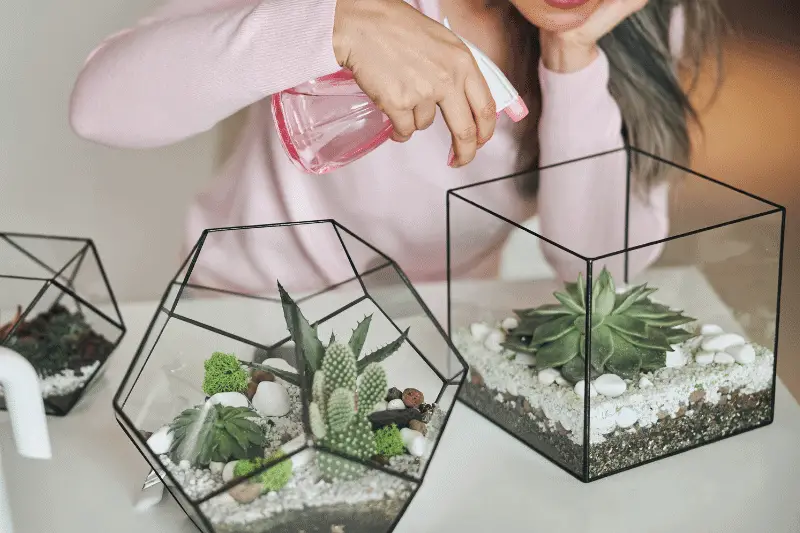
Watering Closed Terrariums
The greenhouse-like structure of a closed terrarium recycles water, as opposed to allowing evaporation of water into the environment like an open terrarium does. With closed terrariums, you will need to observe it to know when you’ll need to water it. A moisture sensor is the most accurate to know when your terrarium will need watering. Again, its really important to not let the potting medium dry out.
Another indicator of how dry or wet your closed terrarium is, is the layer of sphagnum moss. If it looks healthy and hydrated, you don’t need to water your closed terrarium just yet. If it looks and feels dry or dehydrated, it’s time to give your terrarium a good water. You may only need to water your closed terrarium every 3-5 weeks.
You should also open the lid of your closed terrarium for 1 to 2 hours weekly to give it some fresh air and to discourage the growth of mold.
Common Mistakes In Watering A Terrarium
There are two common mistakes that can occur when watering a terrarium: overwatering, and underwatering. Overwatering can lead to either root rot or mold, and underwatering is detrimental to the health of your terrarium plants. We explore the consequences of these mistakes below.
Overwatering Your Terrarium: Root Rot
A healthy root system should be white and firm; if your plants have brown and mushy roots, that’s root rot. This prevents the plant from absorbing the necessary nutrients and will affect the plant’s foliage. Wilting or yellow leaves are a sign that you should check for root rot.
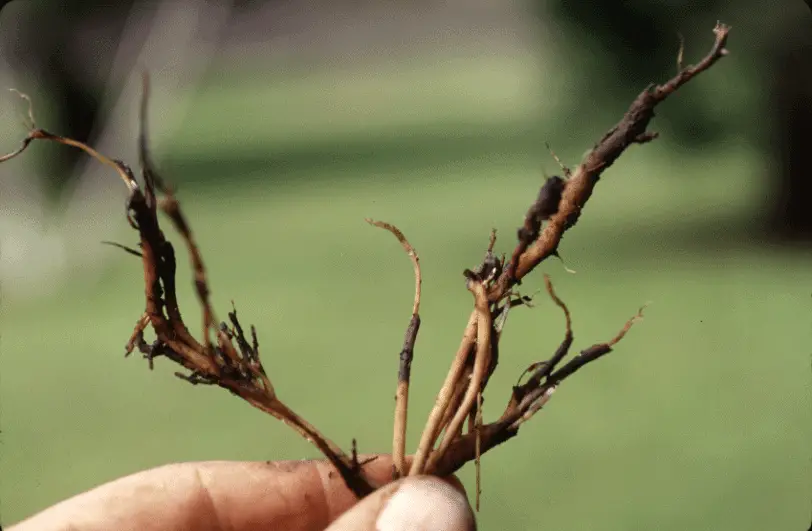
To check for root rot, loosen the soil around the base of the plant with your fingers and remove the plant from the terrarium. Gently brush or shake any soil from the roots and inspect them for rot.
If there is indeed root rot occurring, you will need to check if it is possible to save any part of the plant. If the entire root system is brown and soft or mushy, it is too late to save the plant and it should be disposed of immediately.
However, if you spot some healthy roots that are firm and white, you can try and nurture the plant back to good health. To do this, replant it away from your current terrarium in a fresh potting medium with excellent drainage. See steps below:
- First remove all brown and mushy roots with a small pair of scissors.
- Then clean off all debris from the healthy roots by washing them gently under running water.
- Trim the healthy roots just above any damaged areas, and then replant it. Ideally you should replant in the next 3-4 hours after uprooting your plant.
After all unhealthy roots have been pruned, sterilize your scissors with a bleach solution of 1 part bleach to 3 parts water. This prevents the spread of the root rot to the soil, or other plants that you may use the scissors on.
Overwatering Your Terrarium: Mold
White or grey fluff on the inside walls of your terrarium or on your plants indicate that mold is present. There are usually two main reasons as to why there is mold in your terrarium: overwatering and improper drainage.
Overwatering can lead to high humidity conditions in your terrarium, leading to the formation of mold.
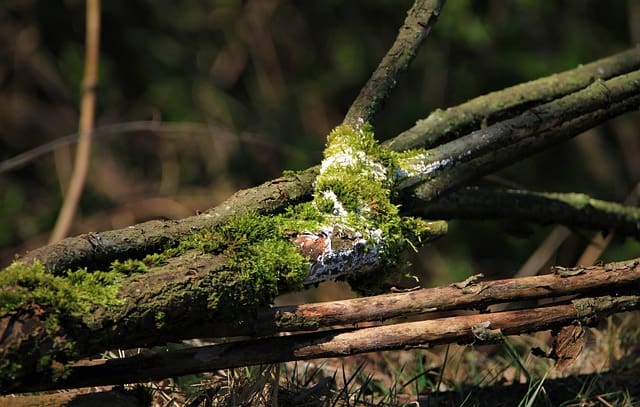
If you see that there is only a little bit of mold on a plant, remove and dispose of the moldy bit. Keep an eye on the plant for the next 3-5 days for any other signs of mold appearing. If your plant is covered in mold, the plant unfortunately has to go! Nothing moldy should stay in your terrarium as mold will grow quickly and take over your terrarium. You may want to replace some or all the plants in your terrarium. Make sure to wash your hands or switch gloves after taking out the moldy plants. This will prevent the spread of mold spores to the new plants.
Not enough drainage or improper set up of your potting layers, coupled with overwatering, can cause the above issues as well. In such cases, you should use a thin skewer and poke holes in your potting medium to introduce some air into the soil to help it dry out. If this doesn’t work, you may have to replace the potting layers entirely. Be sure to set up the layers right to prevent recurrence of mold or root rot!
Underwatering Your Terrarium
Providing too little water, or not watering your terrarium frequently enough can be detrimental to the health of the plants in your terrarium.
Underwatering your terrarium can cause your plants to shrivel up and die. Yellow, droopy leaves and wilting stems are indicators that your plants are not getting enough water. Another way to check if you are underwatering your terrarium is to use a moisture sensor or to use the alternate method of sticking your finger into the potting medium.
If your plants aren’t looking happy, even with regular watering, try watering your terrarium a day earlier than you usually would. For example, if you only water your terrarium every 5 days, try watering it every 4 days instead. Alternatively, you can increase the amount of water you water with.
With both types of terrariums, closed and open, it’s best to keep a close eye on how much water is needed when you first create or receive one. Refer to our guide above on how often to water them.
How Much Sunlight Should My Terrarium Get?
Sunlight is a key energy source for all plants. Plants convert energy from the sun into necessary nutrients through the process of photosynthesis. However, too much sun can damage your plants as well, as the glass walls of a terrarium can magnify the heat received.
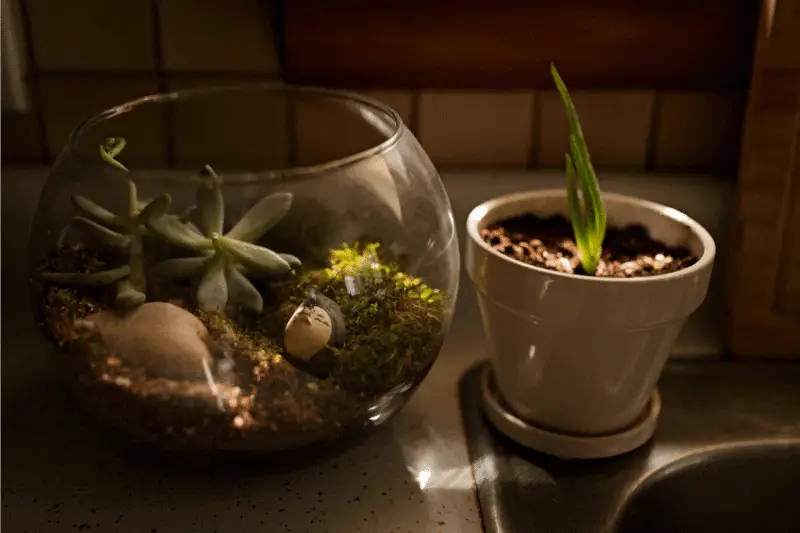
Sunlight Requirements: Open Terrarium
Open terrarium plants such as succulents and cacti tend to be more hardy and sun-loving. While these plants can tolerate high levels of light and heat, it’s best to bring them into the shade during the hottest periods of the day, or risk your plants getting scorched.
It is recommended to leave your open terrarium in a spot with bright but indirect sunlight or partial sunlight. If you have a spot in your house that has full sunlight, you can use a sheer curtain to filter the sunshine so that your plants can still receive sunlight but not excess heat.
Sunlight Requirements: Closed Terrarium
Closed terrariums generally have plants that thrive in warm and humid conditions, being able to create their own water cycle through high humidity. Being closed, the heat from direct sunlight can be magnified through the glass walls of the terrarium. This can cause your plants to burn or scorch. As such, indirect sunlight (or partial shade) is best for closed terrariums.
Keep in mind that heat will affect a closed terrarium more than an open one; while a spot in your house may receive indirect sunlight, it can still be overly warm for your terrarium and you should keep an eye on it to see if the plants are enjoying the warmth and light there.
A clear indicator that your terrarium may be too warm is if the leaves start showing brown or burnt spots. If this happens, firstly, move the terrarium away from the warm spot. Next, you will need to remove parts of the plant that have been burnt. Use a small, sanitized pair of scissors to trim the burnt or browned parts off.
For a more detailed breakdown of sunlight requirements and specific terrarium plants for both closed and open terrariums, I have written article I encourage you to read!
What Should I Do With An Overgrown Terrarium?
Overgrowth can affect both open and closed terrariums, but are more commonly seen in closed terrariums due to their self-sustaining water cycle.
The solution to having an overgrown terrarium is to prune your plants as needed.
Keep in mind that different types of plants have different growth speeds when planting them in a terrarium. You will need to understand your specific plants and their typical growth patterns. If plants are allowed to become overgrown, they will start to invade the space of your surrounding plants, causing them to deteriorate and stunt their natural growth habits. This typically happens because the overgrown plants prevent the much needed sunlight from reaching your other plants. Plants that are overgrown can also ruin the design of your terrarium by growing out of their confined spaces.
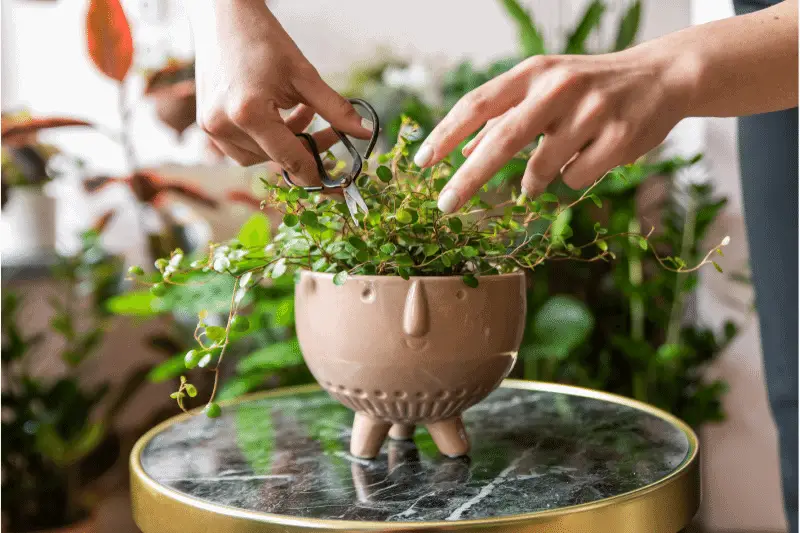
Another bigger problem is when plants in a terrarium become too big, their leaves will constantly be touching the inner walls of the terrarium, which is often wet from condensation. This can increase the chance of mold forming if the plant isn’t pruned or if the terrarium is not aired out. Keep in mind that mold will spread quickly to the rest of your plants in the wet and humid environment of a closed terrarium.
So don’t be shy when it comes to pruning the plants in your terrarium! It took me a while to get the hang of it so if you are unsure, you could try trimming a smaller amount and doing it more often, rather than to do a big pruning session all at once.
When To Prune A Terrarium
Look for the following signs to decide when you should prune your terrarium:
- If there is mold showing on any plants or if you detect root rot – make sure to check all your plants in the terrarium if you do detect this!
- When the leaves, vines, or branches grow bigger than they should.
- If plants start covering the other plants in the terrarium, and sunlight to the whole terrarium is decreased as a result.
- If one plant seems to have had a growth spurt and is affecting the other plants in the terrarium.
How To Prune An Overgrown Terrarium
Most terrarium plants can be pinch-pruned as needed. To do this, you can simply pinch and pull off the part of the plant that you want removed. Keep in mind that if you are dealing with mold or root rot, follow the steps listed above.
For succulents, you can pinch off a ‘leaf’ and regrow that in a separate pot or terrarium. It is a quick and easy way of propagating your plants!
If it’s a plant that tends to ‘clump’ together, it is best to gently remove the plant from the terrarium, separate it into smaller plants and put one back in. The others can then be planted in a pot. If you have ferns in your terrarium, trim them at the base and watch them re-grow.
Other Things To Look Out For
Other things to look out for when maintaining your terrarium are:
- little bugs or critters
- slugs
- snails
- caterpillars
- small insects
On occasion you may wake up to find these creatures crawling around in your terrarium. It is best to remove them as they will eat away your plants.
The best way to remove these insects or slugs is to place a piece of lettuce in your terrarium overnight. In the morning you will find most of your unwelcome guests eating or crawling on your lettuce. You then just simply replace the lettuce and repeat as many times as necessary.
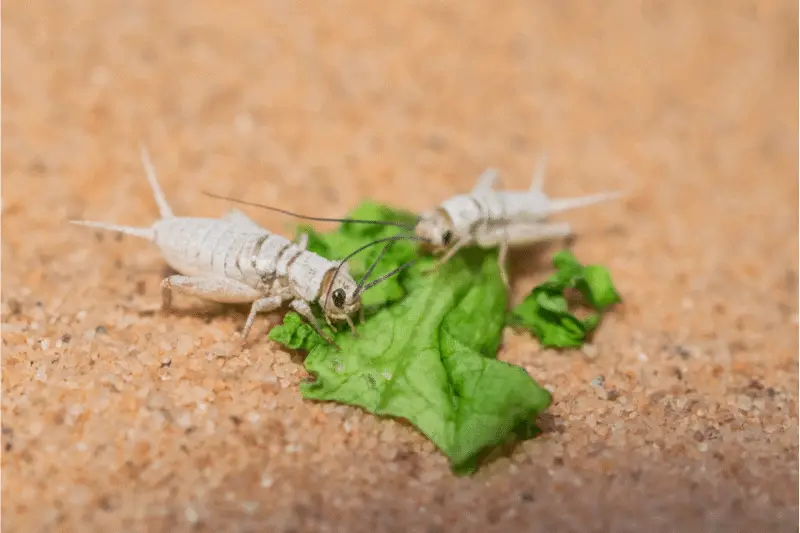
Final Thoughts
When it comes to terrariums, they are relatively easy to care for and maintain as long as you are aware of the key things to look out for.
Be sure to know:
- The difference between open and closed terrariums
- How to clean your terrarium and how often
- Watering requirements for your plants and how often you should water your terrarium
- Looking for signs of root rot or mold
- Sunlight requirements
- How to care for an overgrown terrarium
- Regular pruning of your plants
- Looking for signs of insects or slugs
- Monitoring signs of deterioration daily
I wish you all the best with your terrarium and I hope that this guide has helped you gain a better understanding about terrarium care so that l you can maintain your terrarium with as little daily maintenance as possible!

Meet Brad, the creator behind Vivarium Vibes, where his deep connection with nature and animals truly comes to life.

